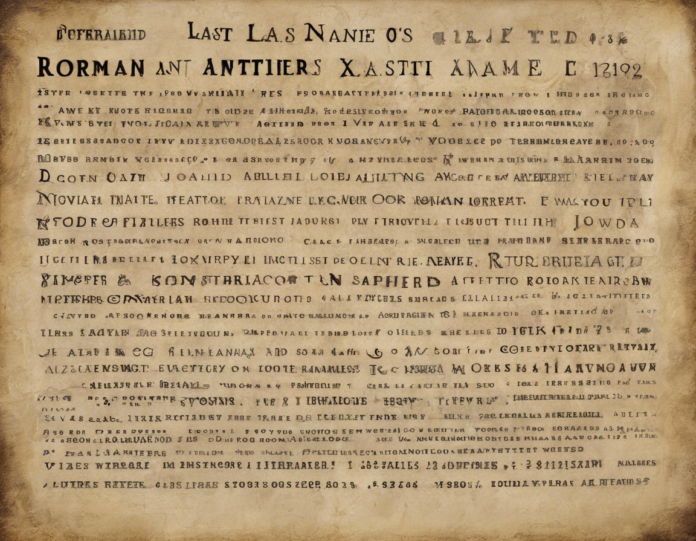The Roman civilization was rich in culture, art, and history, and one aspect of their society that has intrigued many is their naming conventions. Roman names typically consisted of three parts: the praenomen (personal name), nomen (clan name), and cognomen (family name). While most of us are familiar with some famous Roman names like Caesar, Augustus, or Cicero, there is a plethora of lesser-known Roman last names that have fascinating meanings and origins. In this article, we will delve into the world of Roman last names and uncover the stories behind them.
Roman Last Names and Their Meanings
Origins of Roman Last Names
Roman last names were closely tied to the individual’s lineage, occupation, physical characteristics, or notable achievements. The use of the cognomen became more prominent during the Roman Republic, where it served to distinguish between members of the same family. Over time, certain cognomina became hereditary, passing down through generations.
Common Themes in Roman Last Names
-
Occupational Names: Many Roman last names were derived from the individual’s profession or occupation. For example, the surname “Faber” was given to blacksmiths, “Pistor” to bakers, and “Agricola” to farmers.
-
Descriptive Names: Some last names indicated physical attributes or characteristics of the individual. “Calvus” referred to someone who was bald, while “Longus” was used for tall individuals.
-
Geographical Names: Romans sometimes adopted surnames based on their place of origin. Names like “Aquinensis” (from Aquino) or “Tarentinus” (from Tarentum) were common.
-
Matronymic Names: In certain cases, Roman last names were derived from the mother’s name. For instance, the name “Julius” in Gaius Julius Caesar likely originated from an ancestor named Julia.
-
Nicknames: Romans also used nicknames as surnames, often based on the individual’s character or behavior. For example, “Caecus” meant blind, while “Scaevola” referred to left-handedness.
Intriguing Roman Last Names and Their Meanings
-
Corvinus: This last name, meaning “of the raven,” was associated with the Roman general Marcus Valerius Messalla Corvinus. The name likely stemmed from a connection to the mythical tale of a raven guiding a lost shield.
-
Geminus: Signifying “twin” or “double,” the name Geminus was used by various Roman figures. It possibly denoted a twin birth or mirrored qualities in an individual.
-
Caesar: While widely recognized due to Julius Caesar, the name Caesar actually translates to “hairy” or “long-haired.” It was not uncommon for Romans to have cognomina based on physical traits.
-
Maximus: Meaning “greatest” or “largest,” the name Maximus denoted superiority or eminence. It was a popular cognomen among Roman emperors and gladiators.
-
Octavianus: Associated with the first Roman Emperor Augustus, the name Octavianus derived from the Latin word for “eighth.” It likely indicated someone who was the eighth in line or born in the eighth month.
Evolution of Roman Last Names
As the Roman Empire expanded and assimilated diverse cultures, the naming conventions also evolved. Roman citizens from provinces often adopted Romanized versions of their original names or combined them with traditional Roman nomenclature.
Frequently Asked Questions (FAQs)
1. What is the significance of the three-part Roman naming system?
In ancient Rome, the three-part naming convention helped identify individuals within families, clans, and broader social structures. The praenomen served as a personal name, the nomen indicated the clan or gens, and the cognomen distinguished individuals within the same family.
2. Were Roman last names passed down through generations?
While some Roman last names were hereditary, especially prestigious cognomina or those denoting noble lineage, others could change or be dropped based on the individual’s accomplishments or societal shifts. Adoption and manumission also influenced the transmission of last names.
3. How did women’s names differ in ancient Rome?
Women in ancient Rome typically did not have praenomina or cognomina. Their names usually comprised the feminized version of their father’s nomen with a feminine form of their clan’s name. For example, Julia, daughter of Marcus of the gens Julia.
4. What were the most common types of Roman cognomina?
Occupational cognomina were prevalent in Roman society, reflecting professions like Smith, Carpenter, or Potter. Descriptive cognomina based on physical traits, such as Rufus (red-haired) or Niger (black), were also common. Nicknames and place-based cognomina rounded out the diversity of Roman surnames.
5. How did the Roman naming system influence modern naming conventions?
The Roman naming system, with its emphasis on personal, familial, and individual distinctions, has influenced modern naming practices. Elements like surnames denoting occupations, locations, or traits, as well as the importance of lineage and heritage in names, can be traced back to Roman naming traditions.
In conclusion, Roman last names offer a glimpse into the diverse and intricate social fabric of ancient Rome. From occupational ties to geographical roots and descriptive attributes, these surnames carry layers of meaning and history. Exploring the origins of Roman last names not only unveils individual identities but also provides insights into the cultural, societal, and linguistic aspects of one of history’s most influential civilizations.









